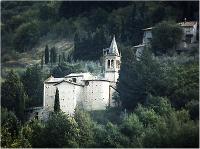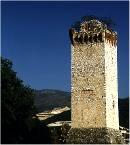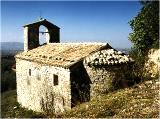Trevi -
Around Trevi
 |
| Chiesa di San Vincenzo Ferreri |
Two kilometres from Trevi in the direction of Foligno, near the Via Flaminia and the remains of some Roman baths, there is the church of Santa. Maria di Pietrarossa, a 14th century therapeutic sanctuary. The massive Gothic entrance is 15th century. A number of 14th and 15th century votive frescoes adorn the interior.
The belief that the sanctuary has beneficial effects for skin is based on three ritualistic components: the water of St John from the nearby well, the red stone embedded in the fifth column of the right hand nave and the fresco of St John.
 |
| Torre di Matigge |
A kilomentre southwards from Trevi, towards the Via Flaminia, stands the church of Santa Maria delle Lacrime. The building dates back to the Renaissance and was erected in 1475 to a design by Antonio Marchisi. Fine bas-reliefs adorn the entrance. The latin cross interior houses the funerary monuments of the Valenti family from the 16th to the 17th century. Above the second altar to the right hangs the ‘last painted work by Perugino (1521), 'Adoration of the Magi with St Peter and St Paul'. The miraculous image of the Madonna, believed to cry and from which the church takes its name, is on the altar of the right hand arm of the transept.
 |
| Chiesa di S. Donato |
© Copyright 2001-2025
by Umbriaonline.com
SCG Business Consulting S.a.s. di Giacomelli E. & C. - Internet Advertising Division - © 2001-2025 All Rights Reserved - P.IVA 01675690562